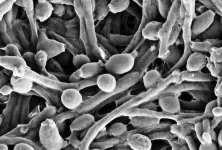(Press-News.org) BIRMINGHAM, Ala. - Uveal melanoma, or UM, is a rare and deadly cancer of the eye, and the mortality rate has remained unimproved for 40 years. Half of the melanomas spread to other organs of the body, causing death in less than a year, so new treatments to preserve vision and prevent death are an urgent need.
Now a preclinical study by researchers at the University of Alabama at Birmingham and Emory University, Atlanta, offers hope -- a small molecule inhibitor has been identified that dampens the potent drivers of this tumor. In mouse models, the inhibitor, KCN1, strongly limited primary disease in the eye and metastatic tumor dissemination to the liver, and animals survived longer, without overt side effects.
Thus, this class of inhibitory compounds shows promise, though the co-leaders of the research -- Erwin Van Meir, Ph.D., professor of neurosurgery at UAB, and Hans Grossniklaus, M.D., MBA, professor of ophthalmic pathology at Emory -- say the drug needs further optimization before clinical use.
"Overall," they wrote in the paper published in the journal Oncogene, "our preclinical studies support the further translation of the KCN1 arylsulfonamide scaffold toward a novel treatment for patients with metastatic uveal melanoma." The uvea is the pigmented layer of the eye.
Prior to this study, it was known that: 1) a hypoxia gene signature, indicative of low oxygen levels in the tumor, is associated with poor prognosis and a high metastatic rate in uveal melanoma; 2) the hypoxia-inducible transcription factor, or HIF, turns on a large number of gene products with critical roles in cancer growth and metastasis; and 3) for UM specifically, HIF promotes tumor progression by regulating proliferation, migration, invasion and adhesion of tumor cells, as well as promoting blood vessel growth to feed the tumor.
Little was known of the role of HIF in directing pro-invasive extracellular matrix remodeling in UM. Changes in the extracellular matrix, including increased collagen deposition and reorganization of collagen fibers outside the cell, is known to aid cancer progression and tumor cell invasion. Extracellular matrix is the non-cellular component of all tissues that provides physical scaffolding for cells and has other biochemical roles.
Hypoxia promotes collagen deposition, in part, because HIF increases production of two gene products, P4HA1 and P4HA2, that are part of an enzyme complex that adds hydroxyl residues to prolines in procollagen. Procollagen is a precursor protein in the complex maturation process that collagen undergoes.
In their study, Van Meir, Grossniklaus and colleagues decided to evaluate the expression of the P4HA1/2 genes in relation to UM patient prognosis, and to determine whether inhibiting hypoxia-induced P4HA1/2 expression in a preclinical model of metastatic UM would yield therapeutic benefit.
They found that P4HA1 and P4HA2 were induced by hypoxia in human UM cell lines, and this induction was reduced by KCN1. Comparison of 46 patients with non-metastatic UM and 46 with metastatic UM showed that P4HA1/2 were significantly overexpressed in patients with metastatic disease. Also, P4HA1/2 expression correlated with poor overall survival in UM patients. This suggests that P4HA1 and P4HA2 can serve as prognostic markers in UM, and that they may be important for malignant progression of the disease and patient survival.
The researchers next turned to preclinical animal models of UM. They showed that KCN1 was abundantly taken up in the liver and the eyes after intraperitoneal injection, and it dampened tumor growth and disease burden at the primary site of the eye, as well as reduced distant metastases in the liver. KCN1 also increased survival in three different models that test the growth of human UM after injection in mice uvea. The inhibitor was most effective at reducing metastases when it was administered early.
At the molecular level, treatment with KCN1 to inhibit the hypoxic induction of P4HA1/2 decreased the hydroxylation of proline amino acids in the procollagen. It also caused cleavage of the collagen and disordered the structure of collagen VI, a mature structural component of the extracellular matrix. These collagen changes correlated with a reduction in tumor cell invasion.
"Our study," Van Meir and Grossniklaus concluded, "suggests that KCN1 has desirable properties as a suppressor of metastasis: It is well tolerated, has excellent distribution to the eye and the liver, and is thus ideally suited for treating metastatic UM."
INFORMATION:
Co-first authors of the report, "Targeting HIF-activated collagen prolyl 4-hydroxylase expression disrupts collagen deposition and blocks primary and metastatic uveal melanoma growth," are Stefan Kaluz and Qing Zhang, Emory University. Additional co-authors are Yuki Kuranaga and Satoru Osuka, UAB Department of Neurosurgery; Hua Yang, Debanjan Bhattacharya, Narra S. Devi, Jiyoung Mun and Mark M. Goodman, Emory University; and Wei Wang and Ruiwen Zhang, University of Houston.
Support came from National Institutes of Health grants CA116804, CA176001, CA180805, EY017045, EY06360, CA138292 and CA13148; and National Natural Science Foundation of China grant NNS81201808. Support also was provided by a Fight For Sight Postdoctoral Award, the Emory Melanoma Prevention and Research Discovery Fund, a Winship Cancer Institute pilot grant, a Central South University Lieying pilot grant, the V Foundation, the Max Cure Foundation, the Samuel Waxman Cancer Research Foundation, the Alan B. Slifka Foundation, and Research to Prevent Blindness, Inc.
Van Meir came to UAB from Emory in fall 2019, and he is the associate director for Shared Resources at the O'Neal Comprehensive Cancer Center at UAB.
Male seed beetles with genital structures that injure females may have greater reproductive success. As new research from Uppsala University shows, females that mate with such males benefit, in the sense that their offspring are healthier. This new piece of the puzzle will help scientists to understand how complex mating interactions between males and females have developedevolved. The study is published in Proceedings of the Royal Society B.
"This helps us understand is connected with the evolutionary dance between males and females of all animal species, ...
A team of University of Houston pharmaceutical researchers is reporting a newly recognized process of drug metabolism in the intestines - followed by recycling through the liver - that could have important implications for developing treatments for intestinal diseases and for taking multiple medications at the same time.
"The intestines play a crucial role in metabolizing and recycling certain plant compounds and drugs," reports Ming Hu, Diana S-L. Chow Endowed Professor of Drug Discovery and Development and the senior author of the paper in eLife. "The discovery has important implications for scientists trying to understand how ...
A new study led by the U.S. Geological Survey outlines a means to better estimate COVID-19 occurrence and trends in populations.
Currently, COVID-19 testing is primarily limited to self-selected individuals, many of whom are symptomatic or have had contact with someone who is symptomatic. While these tests are useful for individual medical treatment and contact tracing, they do not provide health officials with a complete picture of the disease across the population.
"Coordinated sampling of COVID-19 is key to informing health officials as they continue their efforts to control the pandemic, permitting better predictions of disease dynamics and ...
Antibiotic exposure early in life could alter human brain development in areas responsible for cognitive and emotional functions, according to a Rutgers researcher.
The laboratory study, published in the journal iScience, suggests that penicillin changes the microbiome - the trillions of beneficial microorganisms that live in and on our bodies - as well as gene expression, which allows cells to respond to its changing environment, in key areas of the developing brain. The findings suggest reducing widespread antibiotic use or using alternatives when possible to prevent neurodevelopment problems.
Penicillin and related medicines (like ampicillin and amoxicillin) are the most widely used antibiotics in ...
Scientists at Northwestern University in Evanston, Illinois have developed a hydrogel integrated with zirconium-based robust metal-organic frameworks (MOFs) that rapidly degrades organophosphate-based nerve agents used in chemical warfare. Unlike existing powdered MOF adsorbents, this hydrogel composite does not require added water and may be easily scaled up for use in protective masks or clothing. The work appears July 14 in the journal Chem Catalysis.
"Organophosphate-based nerve agents are among the most toxic chemicals known to humanity," says senior author Omar Farha, a professor of chemistry at Northwestern University. "Their use in recent global conflicts reflects the urgent need for personal protective gear, as well as the bulk destruction of ...
(Salt Lake City) - Bacteria's role in gut health has received a lot of attention in recent years. But new research led by scientists at END ...
BOSTON - New research in humans and mice identifies a particular signaling molecule that can help modify inflammation and the immune system to protect against Alzheimer's disease. The work, which was led by investigators at Massachusetts General Hospital (MGH), is published in Nature.
Cognitive decline associated with Alzheimer's disease develops when neurons begin to die. "Neuron death can be caused by improper immune responses and excessive neuroinflammation--or inflammation in the brain--triggered by high levels of amyloid beta deposits and tau tangles, two hallmarks of Alzheimer's disease," explains the paper's co-senior author Filip Swirski, PhD, who conducted the work while a principal investigator in the Center for Systems Biology at MGH. ...
BOSTON - Over the last decade, investigators at Beth Israel Deaconess Medical Center (BIDMC) have been at the forefront of the effort to END ...
New York, NY--July 14, 2021-- A previously unknown kind of human brain cell appears to help people center themselves in their personal maps of the world, according to a new study from neuroscientists at Columbia Engineering. This discovery sheds light on the cellular mechanisms underlying navigation and memory in humans, as well as what parts of the brain might get disrupted during the kinds of memory impairments common in neurodegenerative diseases such as Alzheimer's.
There are two strategies with which humans and animals navigate and orient themselves. One involves locating places, distances and directions in "allocentric" or other-centered ...
What The Study Did: The COVID-19 pandemic was associated with a decline in addiction treatment initiations but more research is needed to understand the cause of the decline in initiations and the extent to which it was due to reduced demand for services or reduced ability to supply treatment.
Authors: Tami L. Mark, Ph.D., M.B.A., of RTI International in Rockville, Maryland, is the corresponding author.
To access the embargoed study: Visit our For The Media website at this link https://media.jamanetwork.com/
(doi:10.1001/jamanetworkopen.2021.17029)
Editor's Note: The article ...




